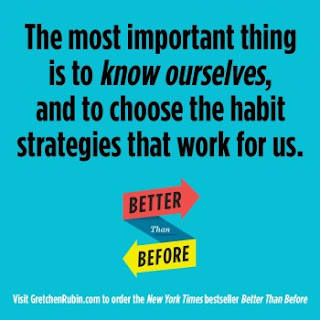The Foolproof Trick to Making Morning Routines Stick
I never understood the power of a morning routine until my late 20s. Does this sound familiar?
Your alarm rings. Snooze. Snooze. Snooze. It’s 9 already. You have class (or somewhere to be) in one hour. 9:20. Up and in the shower. 9:30 struggle with getting dressed. Now it’s 9:40 and it takes 15 minutes to get to school and an additional 10 to look for parking plus 10-15 minutes to walk. Okay seriously it’s 9:45 and now you’re late. You didn’t even have breakfast or coffee before you’re catapulted into your day.
HUMAN TORNADO ALERT
The morning struggle was real. A series of chaos and anxiety tornado-ing around my home and into the car and to the next destination haphazardly. I never liked feeling rushed and yet, I rushed myself. Every. Single. Morning. Why did I do that to myself? Even better, how do I stop and feel successful in the mornings?
My mom tried her hardest (and I mean her hardest - with clanging pots, banging on doors and yelling) to wake her children up early in summers and weekends throughout their upbringing. To her dismay, it didn’t stick. That’s right: Her lesson in adulting fell flat on my ears. Quelle surprise! Suffice it to say, I stumbled and tripped from birth to late 20s.
NO-ONE-SIZE-FITS-ALL ROUTINE
As I “gracefully” age into my 30s, I’ve since absorbed information about morning routines from diverse people like Haruki Murakami and his early start at 4 am to write studiously for five or six hours to Winston Churchill’s daily breakfast of cigar and whiskey and lounging in bed until 11 am. Headlines of productivity gurus and “highly successful” people who’ve embedded morning routines (or who don’t - which suits their personality just fine) made their way into my subconscious over the last two decades.
Wondering how and where to start a routine? Some might opt for a formulaic morning like the Robin Sharma’s 20/20/20 Formula that neatly divides an hour into three equal parts: movement, reflection and growth.
TIP: KNOW YOURSELF
Some people thrive off deadlines and the rushed feeling of jumping from one task to the next. Once I heard Sharma's formula for morning success, I felt doomed to fail even before taking the first step. How did I know? Because I know myself.
The best thing you can do for yourself is to understand who you are and how you function. understand that not all routines will look the same. For habit formation, it’s important to keep in mind the values you want to uphold or goals to achieve. If you haven't already, consider taking the 4 Tendencies Quiz, created by Gretchen Rubin. Understanding how you set and react to inner and outer expectations will open relevant strategies and dismiss others that don't work for your tendency. (I'm a Questioner!)
VISUALIZE YOUR IDEAL MORNING ROUTINE
[activity] Start by visualizing your morning. Close your eyes and imagine what it looks like from point A to point B to point C. Think about some constraints or supports that you need to go from point A to point B and so forth. Plan where to place supports and relevant materials/equipment/instruments to seamlessly infuse actions and habits.
As you run through your ideal morning, anticipate resistance and forgetfulness. Maybe it helps to pair a habit with a recurring one (like taking probiotics (new) with morning water (current)). Or perhaps the strategy of accountability via habit tracker is for you.
Not sure which strategy is for you? Check out Gretchen Rubin's comprehensive list of 21 strategies. Choose one or two that resonates and discard ones that no longer serve you.
Now that you've planned out your morning routine, revisit your nighttime routine and see if there's anything you can tweak for seamless transitions in the AM.
As you run through your ideal morning, anticipate resistance and forgetfulness. Maybe it helps to pair a habit with a recurring one (like taking probiotics (new) with morning water (current)). Or perhaps the strategy of accountability via habit tracker is for you.
Not sure which strategy is for you? Check out Gretchen Rubin's comprehensive list of 21 strategies. Choose one or two that resonates and discard ones that no longer serve you.
TIP: HAVE A NIGHTTIME ROUTINE
 |
| some (like me) might find a habit tracker useful. |
The result of doing small, incremental actions yields profound change over time. The key is to doing it every day. Here's another quote for you: Aristotle famously said, “We are what we repeatedly do. Excellence, then, is not an ac, but a habit.” It is not one thing you do, but a thing you do every day.
THE FOOLPROOF TRICK
The good news is you have the freedom to design your own morning routine. Give yourself permission to do what works for you so long as you’re hitting all the marks. What is it that you want to accomplish? Is it more…
- Relaxation?
- Exercise?
- Reflection and alone time?
- Writing time?
Keeping your Why? in mind: the thing that motivates you will be a resource for when you don’t feel like getting out of bed at 5am for the umpteenth days in a row.
Here it is: The key to making routines stick is to know thyself. The foolproof trick is to build in time based on what you know AKA task transitions.
Task Transitions are mental and physical shifts from one task to another. Like most people, you might have a hard time switching from one task to another without wanting to lose your state of flow: that is, being in the zone.
Sometimes you might need to warm up to starting that second task. You might need to clear off the counter where your husband leaves his tobacco pouch and sunglasses. You might have a hard time putting away the phone after using it to find a word translation.
Adding in transition time is the secret to keeping my mornings productive. But there’s more to it than just adding an extra minute here or there.
TIP: BE REALISTIC
For instance, I have a ritualistic morning drink. I know I need to have this at least 50 minutes before I exercise so that I can *ahem* successfully eliminate it from my body before doing whatever exercise. I know I must consume and *ahem* fully expel it from my body before exercising (running with a full bladder is not a good feeling!)
Be realistic about what you can and can't accomplish. There's no need to squeeze in everything: That's a recipe for disaster! This ties back to our first tip which is to know yourself.
DESIGN YOUR IDEAL MORNING
Where can you add transitions between your morning tasks that would help you be successful? What’re some things you’d like to accomplish or just do?
[activity] Get a pen or pencil and some paper to write down your ideal morning routine. First, in bullet points, what’re some things that must be done within the first ten minutes of waking up:
[activity] Get a pen or pencil and some paper to write down your ideal morning routine. First, in bullet points, what’re some things that must be done within the first ten minutes of waking up:
· drinking water
· bathroom breaks
· tending to a small one?
Write these non-negotiables down on your paper. Then, write down a schedule with your ideal morning routine (in 15, 30 minutes or hour increments). Add in extra time to transition between activities as desired.
Do you prefer to brew coffee at home using a French Press? You might need to add in extra time to grind beans or to set up your phone device so you can listen to your preferred podcast. Whatever your ideal morning routine looks like, be realistic about the time it takes you to go from consuming your coffee to walking your dog. Adding in extra time to transition will smooth any wrinkles and ensure you keep your morning routine productive (or not – whatever works for you).
If you’ve never been able to get a morning routine to stick, don’t be discouraged! It’s not about how early you get up, but about how you use your first few hours of your day.
If you’ve always wanted to get more writing in, more exercise, time to study and improve a skill or a language, or even just quiet time for yourself, using the foolproof trick of adding transition time in your morning routine just may be the glue to make it stick. You won’t feel so pressured to move directly from task to task but allow yourself to ease into each activity no matter the degree of mental or physical strain.
Look to Aristotle’s words for encouragement: “It is well to be up before daybreak, for such habits contribute to health, wealth and wisdom.”
REVIEW
If there's anything I want you to take away from this post, it's to know yourself. Start here and the rest will fall into place. Once you gain personal insight to how you set and meet expectations, finding the foolproof trick to making your morning routines stick will reveal itself. You're on your way to smoother, more productive mornings.
REVIEW
If there's anything I want you to take away from this post, it's to know yourself. Start here and the rest will fall into place. Once you gain personal insight to how you set and meet expectations, finding the foolproof trick to making your morning routines stick will reveal itself. You're on your way to smoother, more productive mornings.




Comments
Post a Comment